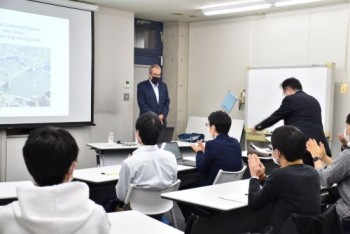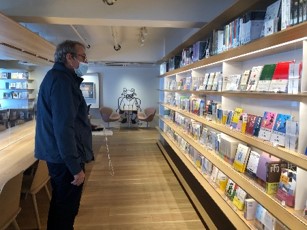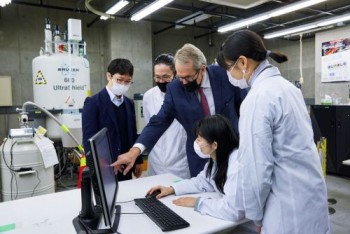Collaboration network at Waseda for Excellent Education and Research
Learn from Distinguished Researcher: Dr. Kalle Levon "Using organic electronics for early-stage detection of diseases"

Dr Kalle Levon is one of the foremost experts in the field of organic electronics, with particular interest in medical diagnostics.
He sat down with us during his stay at Waseda University as a visiting professor, for a fascinating and wide-ranging interview about his research and his long relationship with Japan, especially with Waseda University.
Levon earned his Bachelor of Science and Master of Science in Organic Chemistry from The University of Helsinki in 1976 and 1981, respectively, and a Doctorate in Agriculture from The University of Tokyo in 1986.
He joined the faculty of Polytechnic University in 1989, and became head of the department in 1995 and director of the Polymer Research Institute in 1998. As an associate provost of research and intellectual property (2003-2006), he focused and developed the institute’s patent portfolio and founded the first incubator, Brooklyn Enterprise for Science and Technology (BEST).
He has taught and developed courses in polymer science and engineering, biosensors, tissue engineering, sequence analysis, and protein structure/property relationship, and his research has led to novel discoveries in sensitive transistor arrays as well as bacteria, virus, protein and DNA detection.
He now focuses his efforts on assisting medical doctors with point-of-care diagnostics, using organic electronics to detect early-stage markers of cancer and other diseases. He also has research interests in phase separation in polymer blends and solutions, gelation, conductive polymers, and biosensors, mainly for the improvement of device surface properties.
First, could you tell us about your research background?

To start from the beginning, I come from Finland and I'm a polymer chemist. I started out by working with biopolymers, carbohydrates and papermaking back in Finland. That's how I came to do my Doctorate here in Japan at The University of Tokyo with Professor Junzo Nakano, a famous specialist in Wood Chemistry, making polymers from food waste -- I was still doing chemistry, but in a different area. I fell in love with the academic world in Japan. I had thought I would go into industry, but the atmosphere in Japan was fantastic. I went to the United States for a postdoc for two years, then got a position at Brooklyn, Polytechnic University (nowadays New York University Tandon School of Engineering), which was a world famous educational place for polymer science and engineering.
So I changed from biopolymers to synthetic, electroactive polymers and now back to biopolymers -- I am always a polymer scientist and I've been teaching people how to make plastics all my life.
You do a lot of work in medical diagnostics. Could you tell us more about that? How do you apply plastics to diagnostics?

When things happen in our metabolism, when our cells become ill, they secrete chemicals -- specific markers, which we can detect. The problem until recently has been that we detect diseases such as cancer only after the patient tells the doctor about new, painful symptoms. So doctors can diagnose cancer, but first the patient has to complain about pain or related symptoms, when in fact, long before the symptoms appear, our body is in the early stages of inflammation and/or infection, and the signaling molecules, the biomarkers, start showing up.
Now, say I have an electrode that has either plus or minus charge and then a biological compound comes along and it also has a plus or minus charge. I can detect these charges and monitor them as the compound binds with antibodies. In hospital diagnostics, we add the analyte (sample of our body fluids) first and then we add molecules with optical excitations to monitor them. That way, we can optically see the disease markers as they bind to an antibody. Each one has its own signature, and the selectivity comes from the antibody.
With our system, we can monitor many different diseases at the same time. The key is to detect them early and watch how they change. Take sepsis, for example, a disease which creates a mortal path very fast. It would be very helpful to be able to detect it immediately at the hospital, monitor the whole dynamic process and track the disease, so that we could apply drug therapeutics at the proper moment. That could save thousands of lives annually, and lead to more effective interventions, as well as more precise drug delivery.
Our diagnostic system utilizing antibodies is also useful for detecting coronavirus. Recently I have developed a diagnostic device, which employs a flow channel with antibodies attached through electrical interaction to detect the S protein specific to the virus.
Could you tell us about your collaborative research at Waseda?

I have known Professor Hiroyuki Nishide for a long time in the field of Macromolecule-Metal complexes. Professors Nishide and Kenichi Oyaizu have worked for a long time on organic batteries with electroactive materials similar to those I have worked with. While they are developing the cathode and anode from organic electroactive polymers, I have been developing a system for ink-jet printing the battery, thus developing solid electrolyte in addition to the printable cathode and anode. Right now we work at a very small scale, but we have to start somewhere. Also, Professor Takeo Suga's work is fascinating, especially his surface polymerization work on increasing the quality of the surface. We in Brooklyn apply similar methods for so-called imprinting processes to develop synthetic ligands for diagnostics.
I do a lot of work myself in the lab in the U.S., so during this visit I give lectures and talk about the science and engineering we do, and relate to the problems the researchers have with their polymers, mostly in the battery field. Later, when I have the printing machinery set up, and we start to print the batteries, the Waseda students will come to visit me.
You have had a long relationship with Waseda University. What are your impressions of Waseda, and what changes have you seen?

Waseda is an unbelievable place. A very large private school with over 50,000 students -- I mean, that's enormous. And the campus is beautiful, and The Waseda International House of Literature (The Haruki Murakami Library) is so interesting, as is The Tsubouchi Memorial Theatre Museum (Enpaku). And surprisingly, the Natsume Soseki Memorial Museum is close to Waseda’s guesthouse where I live, so it’s like living in his novel “Kokoro.” All the facilities at Waseda campus are well-built, and with the quality of the equipment and applied methods, the standards are really high. In the last 30 or 40 years there has been enormous progress at Waseda and the professors have done excellent work to raise the money and build this first-class institute.
In the past, communication here was very difficult because of the lack of English skills, but Japan has thoroughly globalized. I have been here many times, giving my talks and interacting with the students, giving them research guidance, and everyone speaks English extremely well. I think the internationalization has been an important component for Japan’s progress.
Do you have any advice for students who intend to be international researchers?

Students have to meet people -- to create a network, and understand who the people are that they may work with. Learning global communication is important for science and technology as for everything else in our lives and societies. In order to do so, acquiring English language skills is indispensable even at the undergraduate level. Even if one's goal is to work in Japanese industry rather than academia, it would be invaluable to stay abroad even for a short period of time. International experience is extremely important.
They also need a broad-based education. In science, everything is constantly shifting and becoming more complex. I started in chemistry, then shifted to polymers, then I jumped to bio and now I’m applying information technology to my research.
That’s because the next step will be data. As you look at my face, the more data points you have, the easier you can recognize me. It’s the same with a disease -- the more data we have, the more we can know about it. So now we have jumped into data and computer science. It can be very confusing -- it's difficult to teach students to handle this situation. That's where broad-based education enters the picture.
Basic education has shifted a lot. Engineers learn biology now -- MIT teaches in the first year that the human body is the best engineered system. When I went to school in the 1970s, we just developed methods and devices. Then came the nineties, and we started to understand materials at the atomic level during the nanotechnology stage, and now we're shifting with Big Data. So scientific people have to understand that things will change, and they have to stay on top of those changes.
Other things are changing too, like funding, for example. In the mid-eighties, when I left Finland, there was no money for PhD work. But now, many years later, they have lots of money for science and tech. It’s the same everywhere else; they produce a lot of doctors. This may seem daunting to students right now, and it’s true, the competition has increased all over the world, but so have the opportunities -- in all aspects of research.
